Core Rules: Difference between revisions
| Line 222: | Line 222: | ||
=== Joker === | === Joker === | ||
For a Joker’s Move, you place it into an unoccupied adjacent square, then you may do that up to two more times. In total, a Joker can traverse 1, 2, or 3 squares during its Move. | For a Joker’s Move, you place it into an unoccupied adjacent square, then you may do that up to two more times. In total, a Joker can traverse 1, 2, or 3 squares during its Move. | ||
[[File:Joker Move.png|none|thumb|200x200px|Possible squares a Joker could end its Move in from its position.]] | |||
=== Other common rules and rule types === | === Other common rules and rule types === | ||
| Line 230: | Line 231: | ||
|- | |- | ||
|Legendary | |Legendary | ||
| | |When a player is resolving their Pawn's ''Promote'' rule, they cannot choose a slain ally piece with this rule to replace that Pawn. | ||
|- | |- | ||
|Summon | |Summon | ||
| | |Some rules (of both faction rules and piece rules) can have the summon tag after their name, which means at some point when resolving that rule's effects you may be required to place a piece - which isn't a part of your starting team - onto the board. | ||
|- | |- | ||
|Major arcana, minor arcana, bone reading | |Major arcana, minor arcana, and bone reading | ||
| | |Some rules (of both faction rules and piece rules) can have these tags after their name. Rules with these tags are considered '''<nowiki/>'faith mechanic'''' rules, and utilise or reference the major arcana deck, the minor arcana deck, and/or bone reading dice pool in some way. You can read about these in greater detail in the '''Faith Mechanics''' section further down this page. | ||
|} | |} | ||
Revision as of 16:03, 18 November 2024
What is Wargame Chess?
Wargame Chess is a turn and activation-based tabletop wargame that uses a chess set, but also incorporates other gaming devices like dice and cards. The core rules to the game are a simple framework to support a plethora of faction options. Understanding faction differences and interactions accounts for most of the game’s nuance.
Wargame Chess is not a variation of traditional chess - though it uses the same pieces and borrows some concepts from it, it is a wholly different game.
What do I need to play?
Two players will generally need the following items to play Wargame Chess:
- A chess set (a board and a full set of pieces).
- 2 or more small items that fit within a board square to represent Joker pieces.
- Deck of playing cards (henceforth referred to as the Minor Arcana deck).
- All 22 Major Arcana cards from a tarot deck.
- Various dice to be used between both players:
- Six or more 4-sided dice (d4's)
- Six or more 6-sided dice (d6's)
- Six or more 8-sided dice (d8's)
- Six or more 10-sided dice (d10's)
- Four or more 20-sided dice (d20's)
- 6 items to represent Trees on the board.
- Items to represent Blessing and Curse tokens.
- we recommend different coloured poker chips, as these sit under most chess pieces very well
- Two distinct types of small dice to represent Advantage and Disadvantage tokens, place these next to pieces to keep track of such token quantities.
- We recommend the dice used for Advantage tokens match the colour of your Blessing tokens, and the dice used for Disadvantage tokens match the colour of your Curse tokens.
Not necessary, but suggested:
- Themed pieces for your favourite faction
- If these are not chess pieces, make sure your opponent knows what they represent before your game starts!
- Notepad
- Use this to record information of a game which is not accommodated by the Activation Tracker.
To start a standard game
The next thing each player must do, after assembling the items mentioned on the previous page, is choose different factions. Each faction has different rules, strengths, handle certain situations better than others, or have tools at their disposal others wouldn't. You can find all factions here.
Most factions are not designed to pick up and play without pondering synergies and tactics. Your game will be far more enjoyable if you take the time to thoroughly read through your options and strategize.
Factions have varying degrees of rules and interactions you will need to be mindful of at key times. If you are unsure of how a rule is supposed to work, read through all the footnotes at the bottom of their page for clarification. If you are still left unsure as to how something functions, discuss and agree to a solution with your opponent.
To assess factions at a glance, they are assigned a star rating. Here is what they mean:
| Star Rating | Explanation |
|---|---|
| ★ | These factions are fairly straightforward. New players and seasoned players alike should be able to understand their nuances quickly. |
| ★★ | Two-star factions require a bit more effort to learn. New players may need a few games to get comfortable with them. Experienced players should be able to understand them within a game or two. |
| ★★★ | Three-star factions may be difficult to pilot for newer players. Experienced players may need to play a few games with them to find their groove. |
Building a team
Once both players have chosen a faction to play as, they will need to build a team list using options from that faction’s page. You can use the Activation Tracker or a notepad to organise your team, note rules that happen at certain times, and track other game information.
| A team consists of exactly 14 points worth of Pieces and Upgrades. |
|---|
Below we will explain how faction rules, piece choices, their quantities, and upgrades fit into your team list.
Faction Rules and Upgrades
Faction rules always apply their effects to that particular faction.
Upgrades are like Faction rules, except they have a point cost in parentheses after their name, and only apply their effects to that particular faction if you account for their cost in your team list. Be sure your opponent knows which Upgrades you have taken in a match.
Piece costs and quantities
The following point costs are the same across every faction in the game.
| Piece type | Point cost |
|---|---|
| Pawns | 1 |
| Kings, Bishops, Knights, Rooks, and Jokers | 2 |
| Queens | 3 |
Under their name, each piece will have a quantity allowance - listing how many of them you can have in a team. Here are a few examples of what you may see in faction entries and what they mean:
| Quantity limit example | Meaning |
|---|---|
| (0-2) | You may have 0, 1, or 2 of this piece in your team list. |
| (2-8) | You must take at least 2 of this piece, and may take no more than 8. |
| (1) | You must have exactly 1 of this piece in your list - no more, no less. |
| (0) | You cannot include this piece in your starting team list. However, some rules may add this piece to your team throughout the course of a game. |
Some rules may add pieces to your team throughout the game, and in some situations can cause you to have more than 14 points worth of pieces on the board! However, you can never have a piece added to the board if doing so would bring a piece type's total quantity beyond its listed quantity range maximum (eg. if your faction allows you to bring 0-2 Knights, your team could never have 3 or more), or the number of pieces that come with a standard chess set (eg. a standard set comes with 8 Pawn pieces, therefore your team can never have more than 8 Pawns).
Multiple options for one piece type
Some factions may list many options for a piece type (eg. They could have two different entries for a Rook). In such cases you may only run 1 of those options in your team list.
The exception to this are Joker options; as each Joker uses a unique model on the board, if a faction lists multiple Joker options, a player may include any/all of them in one list.
There are some situations where players using certain factions are allowed to Summon pieces to their team that may not have been in their starting list. These different options cannot be on the board simultaneously.
As an example, say a player was using "Knight option A" from their faction, and had the opportunity to Summon "Knight option B", they could not do so while option A is on the board. However, once all pieces of "Knight option A" are slain or removed from the board, and there is 1 Knight piece in the Summon zone, they could now Summon "Knight option B". Be sure to effectively communicate any changes during the game like this to your opponent. Going further with this example, if the player summoned "Knight option B" while the other Knight piece was removed from the board or slain, and a rule gave an opportunity for the piece to come back to the board, it cannot come back to the board:
- As "Knight option A"
- If "Knight option B" has a quantity restriction of (0-1) or (1)
Rank
Each piece on a faction’s roster is listed in ranking order - with the highest ranking piece at the top of the table, and the lowest ranking piece at the bottom. Almost every faction has a unique ranking hierarchy, and because of this no rule will ever compare rankings between different factions. Though some rules may compare ranking between pieces in the same faction.
Moves and Attacks
Move
When a piece Moves, it travels along a path as described in its entry (in the Piece types, dice, and common piece rules section below). During a Move, a piece cannot end up in a square occupied by other pieces. As well, a piece cannot end its Move in a square - or pass through squares - occupied by terrain features (like Trees) unless it has special rules that allow it to do so in some capacity.
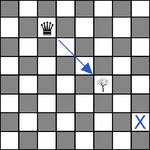
A piece must travel at least 1 square during a Move if possible. If a piece is not able to Move (either by a rule saying it cannot, or perhaps other pieces/terrain are blocking its possible paths of movement), then it is permitted to travel fewer than 1 square.
Attack
When a piece Attacks, it travels along the Attack path as described in its entry (see the Piece types, dice, and common piece rules section below).
A piece may only do its Attack if it would end up in a square occupied by an enemy piece (though some rules allow pieces to Attack non-enemy things, or even Attack allies). While a piece is Attacking another, both count as occupying that square and must complete this Attack sequence to resolve this.
When it does so, the owners of each piece have an opportunity to spend Advantage and Disadvantage tokens, apply modifiers, and/or resolve rule effects before dice are rolled.
Once those - if any - have been spent or applied, each player will roll the appropriate dice for those pieces simultaneously, sum the roll results, apply any other modifiers (a few rules in this game grant a bonus after a roll has been made), and compare the totals.
If the Attacking piece has a greater total, they have slain the Defending piece, and it is placed in the ‘slain’ zone on their player's Activation Tracker.
If the Defender has an equal or greater total, they do one of the following:
- Place the Attacker in an unoccupied adjacent square and give them a Disadvantage token, OR…
- They place themselves in an unoccupied adjacent square and gain an Advantage token.
Either of these options are what is referred to as Combat Movement.
Piece types, dice, and common piece rules
Each piece type uses a specific type of dice for their rolls. The dice used for a type of piece are universal, and not different between factions. Likewise, the way each piece type Moves and Attacks are universal, and not different between factions.
There are a few special rules listed below in each piece type’s entry. Pieces of a particular type will have these rules by default and will not be listed in a faction’s entry. However, some factions may have their version of a piece not have one of these rules (eg. a handful of factions’ Pawns lose their Promotion rule) - it is assumed that all piece options of a particular type have the rules listed below unless a rule mentioned in their faction entry says otherwise.
Pawn
A Pawn may Move up to 1 square vertically or horizontally, and Attack up to 1 square diagonally.
Pawns use 2D4 for their dice and have the following common rules:
- En Passant:
- During its first Activation of the game, you may Move this Pawn twice.
- Promotion:
- At the start of this Pawn's Activation or Reactivation, if it is within your opponent's deployment zone, you may remove it from the board and place a slain, non-Legendary positional into the square that Pawn was just in. This positional counts as having Activated only if it Activated earlier this turn.
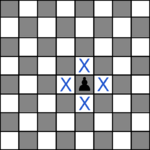 |
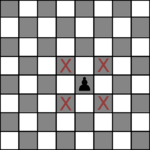 |
Rook
A Rook may Move up to 8 squares vertically or horizontally, and Attack up to 8 squares vertically or horizontally.
Rooks use 2D6 for their dice and have the following common rule:
- Castle
- When this Rook ends their Move adjacent to a non-Rook ally, they may swap places with them. If they do and that ally is lower in rank than this Rook, give that ally an Advantage token; if that ally is higher in rank than this Rook, instead remove a Disadvantage token from it (if it has any).
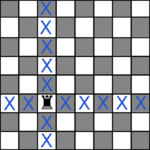 |
 |
Knight
A Knight's Move places it into a square which is two squares vertically and one square horizontally from its current position, or two squares horizontally and one square vertically, jumping over other pieces or terrain; it Attacks this way as well.
Knights use 2D6 for their dice and have the following common rule:
- Mounted Advantage
- When Attacking a non-Knight enemy, if there are other enemies adjacent to the square that this Knight and its target are in (during an Attack resolution, both pieces temporarily share a square), roll this Knight’s dice at Advantage.
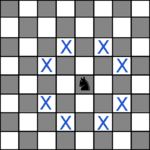 |
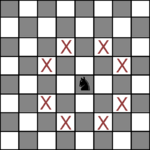 |
|---|
Bishop
A Bishop may Move up to 8 squares diagonally.
Bishops use 2D6 for their dice, and have no common special rule.
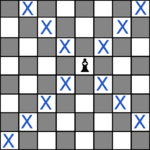 |
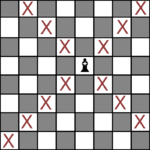 |
|---|
Queen
A Queen may Move up to 8 squares vertically, horizontally or diagonally, and Attack up to 8 squares vertically, horizontally, or diagonally.
Queens use 2D8 for their dice, and have no common special rule.
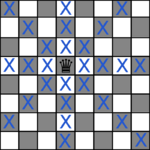 |
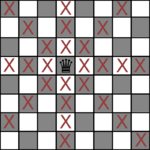 |
|---|
King
A King may Move up to 1 square vertically, horizontally or diagonally, and Attack up to 1 square vertically, horizontally, or diagonally.
Kings use 2D10 for their dice, and have the following common rule:
- Faction Leader
- When this piece is slain, their player loses the game immediately.
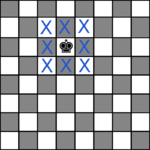 |
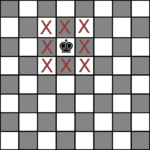 |
|---|
Joker
For a Joker’s Move, you place it into an unoccupied adjacent square, then you may do that up to two more times. In total, a Joker can traverse 1, 2, or 3 squares during its Move.
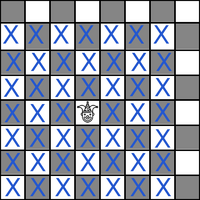
Other common rules and rule types
| Rule or rule type | Description |
|---|---|
| Legendary | When a player is resolving their Pawn's Promote rule, they cannot choose a slain ally piece with this rule to replace that Pawn. |
| Summon | Some rules (of both faction rules and piece rules) can have the summon tag after their name, which means at some point when resolving that rule's effects you may be required to place a piece - which isn't a part of your starting team - onto the board. |
| Major arcana, minor arcana, and bone reading | Some rules (of both faction rules and piece rules) can have these tags after their name. Rules with these tags are considered 'faith mechanic' rules, and utilise or reference the major arcana deck, the minor arcana deck, and/or bone reading dice pool in some way. You can read about these in greater detail in the Faith Mechanics section further down this page. |
Commonly used shorthand terms
In the rules here, and in various faction rules, you may encounter the following terms.
Positional
- A positional is any piece that isn't a Pawn. Kings, Queens, Bishops, Knights, Rooks, and Jokers are all positionals.
Board Half
- A player's board half comprises the four board ranks closest to them.
Success / Failure
- Some rules or effects mention a condition being a roll succeeding or failing, this is done to keep wording brief. A success of a roll would be if the action taking place for the piece rolling did end up happening, and a failure would be the opposite.